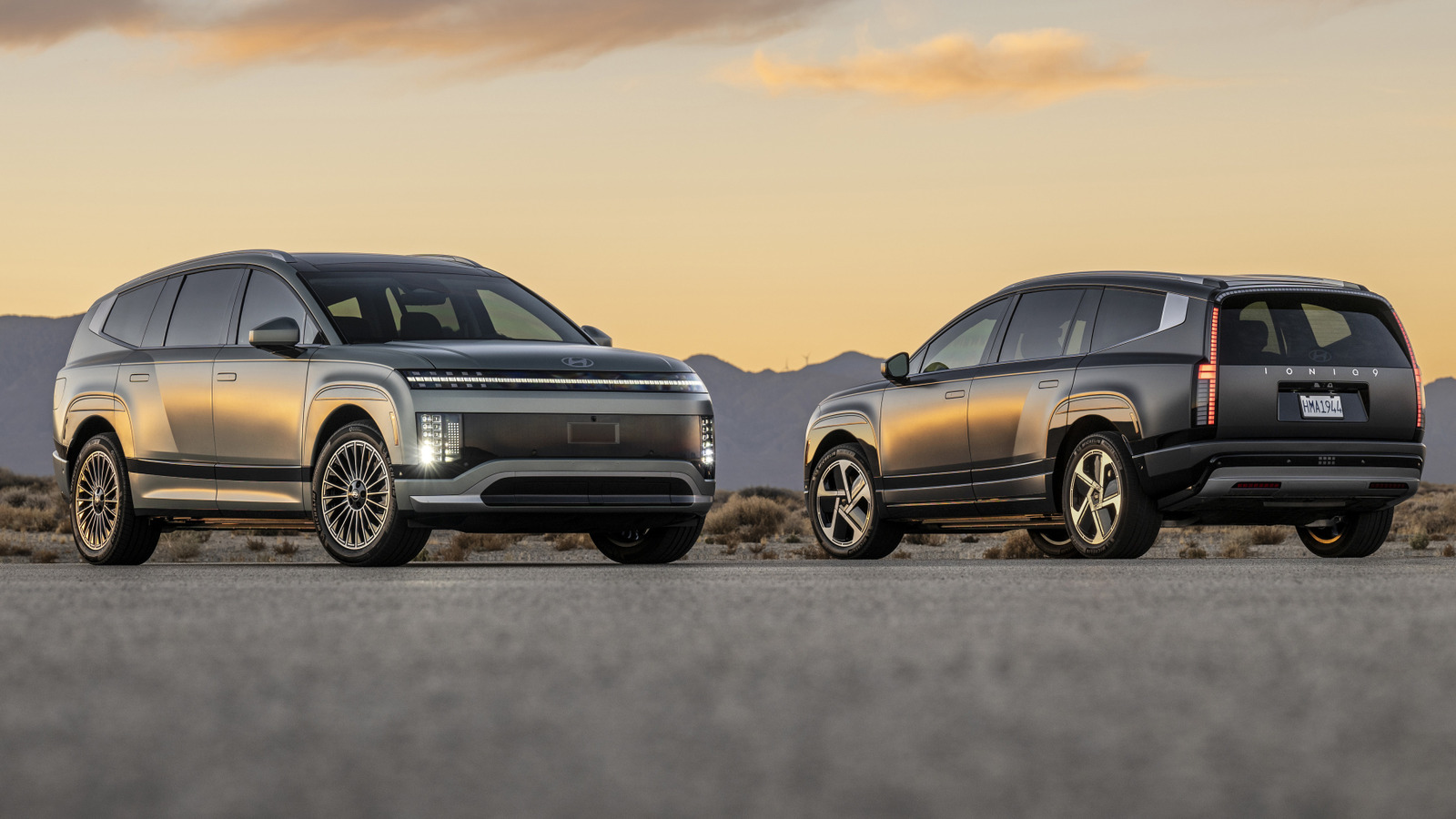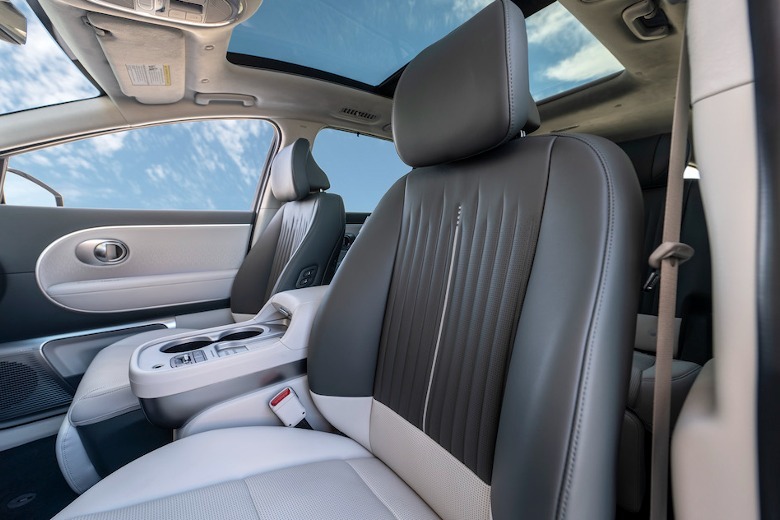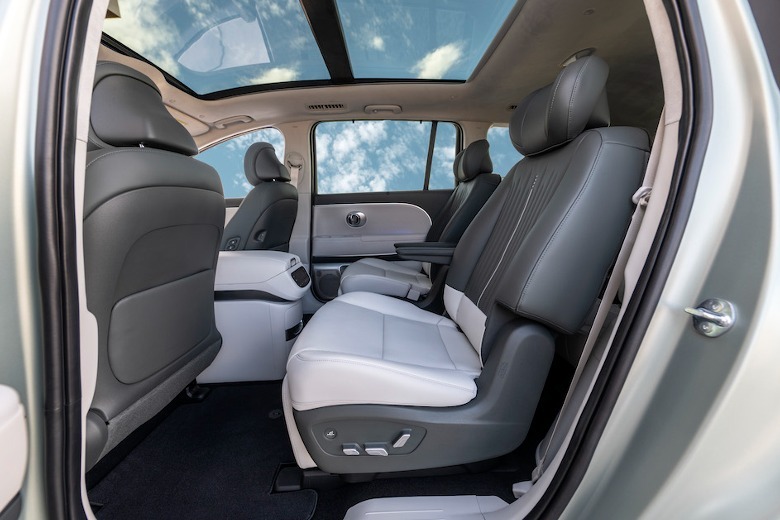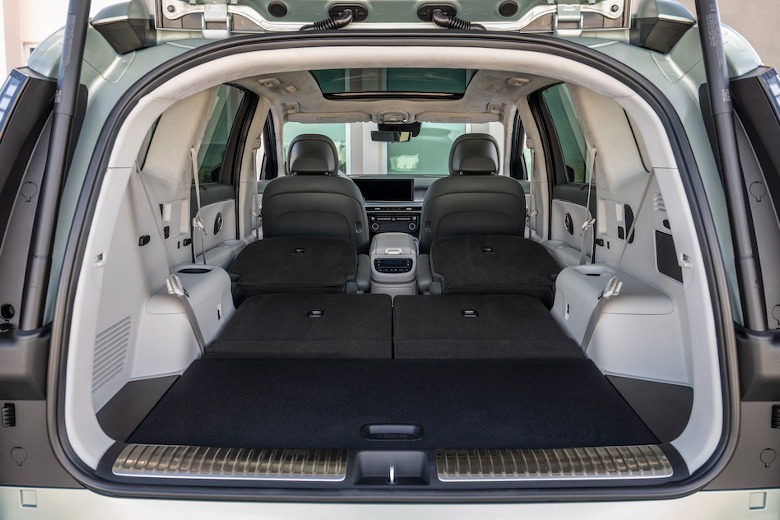There’s a new flagship EV SUV in town with a Hyundai badge on the nose: the IONIQ 9. An all-new three-row, seven-passenger SUV, the IONIQ 9 offers quite a bit of range, impressive space, and a luxurious vibe. To my eyes it looks like an SUV combined with a minivan in the best of ways. It offers some of the modern-retro vibes that the IONIQ 5 and 6 designers cultivated with all sorts of pixelated design elements incorporated into the headlights, taillights, and even the charge-port door. Hyundai’s E-GMP (Electric Global Modular Platform) provides the underpinnings for the IONIQ 9, the same platform that the Kia EV9 rides on. And, while these two three-row SUVs from the sister brands are similar, the new IONIQ 9 has some features that set it apart.
Advertisement
The IONIQ 9 has a massive 110.3-kWh battery (compared to the EV9’s already-large 99.8 kWh battery) with an estimated range as large as 335 miles on long-range models. According to Hyundai, the goal is for every IONIQ 9 to have over 300 miles of range – something that will certainly help it stand out in the class. It’s admittedly a limited class of rivals with only a few three-row EV SUVs available, like the Rivian R1S, the Tesla Model X (and to some degree the Model Y), and the aforementioned EV9. But the IONIQ 9 has an upscale feel from the jump and lots of impressive equipment, so it’s poised to be a strong competitor from day one.
What’re the specs for the new IONIQ 9?
At launch, there will be two versions of the IONIQ 9: Long-Range and Performance. The Long-range will be available in rear-wheel drive and all-wheel drive configurations, while Performance models will be all-wheel drive only. Long-range rear-drive models are a little down on power, putting out just 215 horsepower, but all-wheel drive models get a bump to 303 hp.
Advertisement
Performance models get 422 horses which should make them capable of sprinting from zero to 60 miles per hour in just 4.9 seconds. Base long-range models can tow as much as 3,500 pounds, while all-wheel drive models of all types are rated at 5,000 lbs of towing capacity.
Charging from 10% of the IONIQ 9’s battery up to 80% is estimated to take about 24 minutes in ideal conditions, using a 350 kW charger. The IONIQ 9 will launch with a NACS charging port (no adapter required here) which means you’ll be able to plug it in at Tesla Superchargers. Charging at these stations is currently one of the best nationwide options available, and it’s a big upgrade that should simplify things for EV owners. That said, as more EVs begin to use these stations, it could cause longer waits to charge if other charging stations don’t switch over quickly.
Advertisement
What’s the IONIQ 9’s interior like?
If you’ve been in any of Hyundai’s IONIQ vehicles lately, the 9’s dashboard and user interface will be very familiar. Two 12-inch displays are used for the digital gauge cluster and the central touchscreen infotainment system. An 8-speaker stereo is standard and an optional 14-speaker Bose system is available. Much like a retro minivan, the IONIQ 9 also has second-row swivel seats. They allow for the second row seats to be turned around 180 degrees when the vehicle is stationary, though sadly U.S. spec cars won’t have this option.
Advertisement
At 199.2 inches long (5,060 mm according to Hyundai) the IONIQ 9 is just 2 inches longer from nose to tail than the Kia EV9, and 9 inches longer than the current Santa Fe. That means plenty of legroom in both the second and third row for adults, and a decent amount of cargo space. At the risk of sounding like a broken record, the IONIQ 9 has a flat floor, like a minivan which makes access to the second and third rows relatively easy.
It also makes room for the “Relaxation” seats. These seats in the first and second row can fully recline (it brings to mind business-class flights) and there’s an optional leg rest too. The seats offer massage function, too.
More features and tricks up the IONIQ 9’s sleeves
There are a long list of features for the IONIQ 9, both standard and optional, that are worth mentioning. Like most modern EVs, the IONIQ 9 offers driver safety aids like blind-spot monitoring, parking sensors, forward collision warning, and lane-keep assist. Wireless Apple CarPlay and Android Auto are standard, along with features like a wireless charging pad and lots of USB-C ports to charge your various devices in all three rows of seating.
Advertisement
There’s also Hyundai’s UV-C sterilizer (also available in the Santa Fe) which uses UV light in a small tray that can sterilize and disinfect items like your smartphone. The IONIQ 9’s center console (referred to as the “Universal Island 2.0”) gives passengers multiple storage options for both the first and second row, and slides forward and backward to make access easier.
In some markets around the world (though not the United States) the IONIQ 9 will also get digital side mirrors. Instead of physical mirrors on the outside of the car, cameras will be used to display side-rear view images on small monitors inside the car. Hyundai boasts that it offers zoom functions to aid with reversing the vehicle, as well as wide-angle rear-view vision.
Advertisement
How much will the IONIQ 9 cost?
Hyundai hasn’t confirmed prices yet, so it’s left to us to take an educated guess as to the cost of their new EV SUV. There isn’t really much to compare the IONIQ 9 to in Hyundai’s lineup – at least not when it comes to electric SUVs. The IONIQ 5 and 6 are significantly smaller vehicles, but they’re a pretty good starting point. The IONIQ 6 starts at $37,750 (plus $1,150 destination fee) and top models have an MSRP of $54,500 before options. The standard 2025 IONIQ 5 ranges in price from $42,500 (plus $1,475 destination fee) up to $58,100. Both those models will likely undercut the three-row IONIQ 9 significantly.
Advertisement
The Kia EV9 is undoubtedly the closest direct comparison: while prices there start as low as $54,900 (plus $1,495 destination fee) on base models, the flagship version of the EV9 (the GT-Line) has a starting price of $73,900. So, the base IONIQ 9 will likely start out somewhere in between those numbers thanks to its luxury leanings. Don’t be surprised if you see base models of the IONIQ 9 in the $60,000 range and high-end versions closer to $80,000. At least — for now — it’s expected to qualify for the full $7,500 federal tax credit.
Hyundai says that the IONIQ 9 will debut in Korea and the United States in early 2025, followed by launches in Europe and other markets later in the year.










